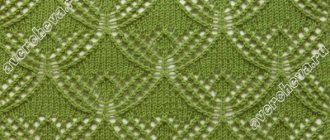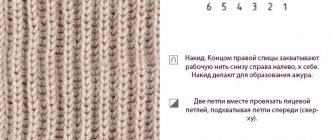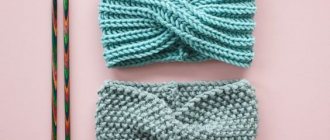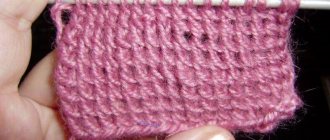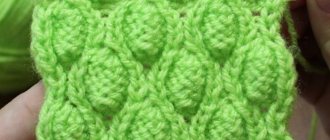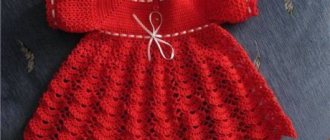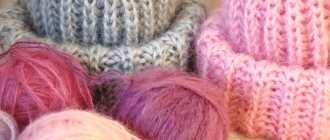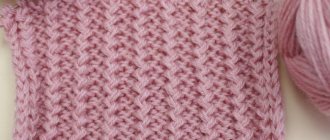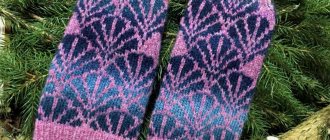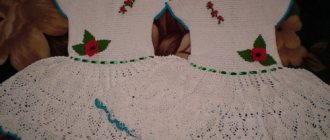Knitted blouse for summer 2021 with knitting pattern
A very unusual model, apparently a novelty from a German magazine. Although it is quite voluminous and seems warm, it is very suitable for summer if you do not use wool, especially since the description indicates 100 cotton (50 g / 90 m). And summer is not always and not always hot, but for cool evenings this is what you need!
The pattern is designed for sizes 39-42 (which corresponds to our 46-50), but it is quite possible to reduce it if necessary. Thread consumption is approximately 300 grams.
First, let's understand the conventions.
- vertical line - facial loops
- horizontal line (-) – purl
- empty square - apparently also knitted, a separately selected fragment of braid knitting (light or dark - this is the color of the threads)
- cross stitch (x) – garter stitch
- plus (+) - edge.
There is no translation of the description, so this is just my guesses and reasoning.
Judging by the places where the edge marks are marked, and the holes throughout the blouse in the photo, I concluded that it is necessary to knit from separate strips. There should be only 10 of them (five on the back and the same number on the shelf, in any case, their total number should be even). We start five of them with light threads, and the second part with dark threads and place them alternately with each other in a checkerboard pattern.
We knitted 15 rows of one strip, put it aside without closing the loops.
Next, we knit similarly all other parts, also fifteen rows each.
And when knitting the 16th row, you will need to combine the stripes in pairs in a checkerboard pattern of colors and cross the loops as in braids:
Slip 6 stitches (the left side of one strip) onto an additional knitting needle, knit the next 6 stitches on the right side of the second strip, using the knitting needle on which the stitches of the first strip are, then return the removed stitches to the second strip and knit further.
Thus, in this row, all the stripes will be combined into one whole canvas, and the color in each of them will change.
Next, we continue to knit separately again until the next row, where the crossing will be performed.
On the pattern, the dotted line indicates the sides and middle, and therefore the front and back are knitted at the same time, there will be no side seams at all. They will only go on the shoulder and sleeves.
Having reached the line of the sleeves, we attach three more strips for each and continue to knit the entire fabric upwards according to the same principle as from the very beginning.
If anyone has other opinions, please write.
The origin and development of handicrafts
In almost every modern family, someone has the skill of knitting or crocheting. Meanwhile, knitting arose in ancient times. Already the ancient Greeks and Romans could boast of the ability to work with tools to create simple knitted fabrics. Excavations uncovered small fragments of knitted items, as well as frescoes and wall paintings depicting noble people wearing knitted clothing.
The skill reached its greatest flourishing during the Middle Ages. Expeditions and Crusades brought the basics of knitting to Europe, where ladies enjoyed needlework. For a long time, only the nobility could afford to tap their knitting needles rhythmically, because the prices for yarn exceeded all imaginable limits. Processing materials to create thread required exorbitant costs, but this all changed with the advent of spinning machinery. When ordinary people had the opportunity to knit, many patterns arose, most of which are used in modern models.
What allowed handicrafts to go such a long way and not lose popularity even after the advent of special mechanisms that facilitate painstaking work? The art of knitting was passed on to the next generation so that children could teach their grandchildren in the future. Knitting especially often attracts girls who watch their mother or grandmother work. The older generation, trying to satisfy the curiosity of the kids, teaches them ancient handicrafts.
Knitting has found wide application in the fashion world. Each collection includes a model line of knitted products.
Related article: Crochet beret with a pattern of embossed columns
Summer women's blouse knitted with raglan
A fairly popular model in the oversized style with raglan sleeves and an openwork pattern. It was published in Sabrina magazine.
Sizes: 38-42 (44-48). From the table you can determine yours.
Yarn – linen (50 g/110 m), knitting needles – four (straight and circular).
Basic knitting - according to pattern 1 striped.
To calculate the loops, you need to take into account that the number is a multiple of the number of loops in the repeat, i.e. 3rd, plus 1 and plus 2 edge.
Eight rows in the pattern are stockinette stitch, the next two are purl stitch and two more are openwork.
It is clear that in the purl rows we knit the loops according to the pattern. And in the 12th there are such features: the 1st yarn over is purl, and the 2nd yarn over is purl crossed.
The second pattern is for knitting an openwork pattern in the sleeves.
Cast on 109 (127) stitches and first purl 2 rows for the placket, and then according to the main pattern.
In the 3rd row, add 20 stitches, distributing them evenly.
In each odd row, add 1 stitch along the edges (21 times) for side bevels.
Having knitted 22 cm in height from the bar, bind off 2 stitches on both sides, then 16 times in each 2nd row and 14 (18) times alternately: either in the 2nd or 4th rows.
47 (49) loops will remain on the knitting needles. We knit the front in the same way as the back.
Sleeves The number of loops that need to be cast on the knitting needles is 35.
1st row - purl, and from the second row we knit according to the openwork pattern. We do not close the loops at the end of knitting.
Assembly We sew the sleeves between the raglan lines of the back and front, starting from the top.
The remaining loops of the front, back and sleeves need to be transferred to circular knitting needles and knitted on them.
1st row – knit, evenly decreasing 8 stitches.
2nd row – purl. Close the loops.
Sew side seams. Along the lower edge of the raglan bevels and the lower edges of the sleeves, cast on 86 (110) stitches on circular needles and knit 2 rows as in a plank, but without decreasing.
Yarn selection and color scheme
A beautiful top can be knitted for the summer from cotton or acrylic yarn. Basic requirements for manufacturing materials:
- environmental friendliness;
- good breathability;
- ability to absorb moisture;
- pleasant tactile thread structure.
To knit a top with knitting needles, it is better to take yarn with a small percentage of synthetics - the finished product is worn directly on the underwear, so it should not prick.
The color of the product should be combined with other clothing. The most common summer shades are beige, sand, white, and turquoise. You can combine contrasting tones - such a combination looks very interesting in the finished product. At the same time, novice knitters are not recommended to combine more than 2-3 colors, as this complicates the knitting of the top.
Cotton
Acrylic
As for knitting techniques, the simplest options for relief decoration are popular:
- braids (as a rule, this type of knitting is used to make straps);
- cones;
- pimples.
On children's and teenage T-shirts, an ornament that imitates chess squares looks good, and it should be contrasting. For example, red and white, brown and yellow, orange and green. This top can be worn with jeans and shorts.
Braids
Cones
Pimples
Patterns and descriptions of knitting a summer cotton blouse
A very casual model with an expressive, rich openwork pattern and exquisite cutouts on the shoulders.
Suitable for sizes 38-40 (46-48).
For knitting you will need cotton yarn (50g/80m), knitting needles No. 4 and 5. Patterns used: openwork and 1x1 elastic. For the first, there is a diagram and a detailed description of all the symbols on it.
And we knit the elastic band by alternating the 1st front and 1st purl loops.
Back On knitting needles No. 4, cast on 87 (101) loops and knit 8 cm with an elastic band.
Then we switch to needles number 5 and continue working according to the openwork pattern. In each 2nd and 4th row on the sides we add 2 loops (127 (141) sts). Then you need to cast on additional loops for the sleeves: 4 times, 2 in each 2nd row and one more time, 4 loops on both sides. And then continue knitting with an openwork pattern. (151 (165) p).
After 41.5 (45) cm from the bar, leave 3 stitches for the shoulder bevel on both sides, then in each 2nd row 14 times for 3 stitches and 4 times for 4 stitches), i.e. knit further shortened in rows. At the same time, 55 (58.5) cm from the bar, bind off the middle 27 (33) loops for the neckline and finish both sides separately. To round along the inner edge, close in each 2nd row 1 time for 3 sts and 1 time for 2 sts. After 57.5 (61) cm from the bottom bar, continue working on all remaining 57 (61) sts of shoulders with an elastic band to complete the top bar. At the same time, knit the turning yarn overs with the previous or subsequent loop together according to the pattern to avoid the formation of holes. When the width of the bar is 2 cm, close all the loops according to the pattern. Before
We knit it like a back, only the neck should be made deeper.
To do this, after 49 (52.5) cm from the bar, close the middle 11 (17) sts, then to round the inner edge, close in every 2nd row 2 times 3 loops, 1 time 2 loops and 5 times - 1 loop. Assembly
Shoulder seams should be spaced 1 cm at the outer and inner edges, and 3 cm in the middle, so that there are slits in the sleeves.
Along the edge of the neckline, cast on 100 (112) stitches on circular needles and knit the placket with an elastic band 2 cm wide.
At the bottom of each sleeve, also make strips with an elastic band of the same width. Finally, sew the sides and the bottom edge of the sleeves.
For ladies with curvy figures
Women with curvy figures are often embarrassed to show off their silhouette. Meanwhile, small errors can be easily hidden with the help of an openwork pattern. We invite you to familiarize yourself with a master class on knitting an openwork cotton blouse for obese women (size 50-52).
The straight silhouette combined with the flowing, loose texture of the product will visually reduce the volume, and the braid pattern will make the figure slimmer.
To create a blouse you will need:
- 600 g pink cotton yarn;
- knitting needles No. 4.5;
- hook number 4.
To knit fancy patterns, use the pattern below:
In addition, garter stitch, stockinette stitch and a large double-sided pearl pattern are used, which is performed according to the following pattern:
The product is made with two folds of thread. The back is knitted from the bottom up. Cast on 86 stitches and make 6 rows in pearl stitch. Work the next 12 cm in stockinette stitch, knitting 4 loops along the edges of each side with a pearl pattern. From 12 to 42 cm the product is knitted in stockinette stitch. Once the back length reaches 42 cm, make 4 rows in garter stitch. Next, you need to make an increase to form the sleeve. On each side, first add 4 loops, which are knitted in the following order - 4 “pearl” loops, 2 in stockinette stitch, 82 in pattern No. 1. Then follow 2 loops in stockinette stitch and 4 loops in pearl pattern. Increases are made in every 4th row in the stitch area of the stockinette stitch. On each side, expand the fabric by 1 loop, increase 11 times so that there are 116 loops on the knitting needles.
When the fabric reaches a length of 65 cm, knit 4 rows with a pearl pattern. Then cast off 29 stitches on each side for the shoulders and cast off 58 stitches separately to form the neckline.
The front piece consists of 86 loops. The first 6 rows are knitted with a pearl pattern. Then the loops are distributed in the following order - 4 loops are knitted with a pearl pattern, 12 with stockinette stitch, 16 loops with pattern No. 2 and 22 loops with pattern No. 3, 16 with pattern 2, 12 with stockinette stitch and 4 with pearl pattern. When the length of the fabric reaches 12 cm, the outer loops begin to be sewn using stockinette stitch. After the back reaches a length of 42 cm, knit 4 rows in garter stitch, continue knitting, distributing the patterns as before to a height of 65 cm. All loops are closed in the same way as on the back.
Article on the topic: Painting sneakers with your own hands: master class, oil paintings
The moistened parts are chipped, dried and shoulder seams are made. When sewing the parts along the side line, leave 12 cm long slits at the bottom. The neckline is finished using a crochet hook.
How to knit a summer blouse for obese women
A good option for a feminine and at the same time sporty blouse with a boat neckline and slits along the edges and on the shoulders. It can be knitted in large sizes; it will fit perfectly on obese women, and thin ones too.
Sizes indicated on the pattern: 38/40 (42/44) 48/50. This is again the model from “Sabrina”, the correspondence table is the same as the one posted above.
We knit from cotton with knitting needles number 4.
Cast on 115 (129) 143 stitches using a cross cast-on and knit 8 cm with an elastic band (strap).
And then continue with an openwork pattern for another 44.5 (44.5) 52 cm.
Finally, knit the top bar, also 8 cm wide (elastic band), and bind off the loops.
The front is exactly the same as the back.
Sleeves
The sleeve trims consist of two parts, running along the back and front, so they must be knitted separately.
First, cast on the knitting needles 18 (21) 24 cm long loops along the upper edge of the front (48 (54) 60 loops) and knit an elastic band 9 cm wide.
And then perform them in the same way, picking up loops along the back.
Assembly
Sew the sides, leaving an 8 cm cut at the bottom - this is exactly what will fit on the bar.
Sew the sleeves only in a few dots (about 1 centimeter each), marked on the pattern with asterisks.
